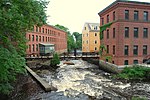Carson Beach, South Boston

Carson Beach is a public beach in South Boston, Massachusetts. It has also been known as L Street Beach. It is maintained by the state's Department of Conservation and Recreation. The beach is a part of a three-mile segment of parks along the South Boston shoreline. The closest subway stop is the JFK/UMass station on the Red Line, approximately a half-mile away. In the mid-1990s, the beach's water quality was deemed unsafe due to sewage matter and other biological debris, and the beach had to be shut down. As of 2019, the water is usually approved for swimming. The beach was named after the winner of a city-sponsored swimming contest between the nearby Mosely and Carson Street Swim Clubs in Dorchester.
Excerpt from the Wikipedia article Carson Beach, South Boston (License: CC BY-SA 3.0, Authors, Images).Carson Beach, South Boston
Boston HarborWalk, Boston South Boston
Geographical coordinates (GPS) Address Nearby Places Show on map
Geographical coordinates (GPS)
| Latitude | Longitude |
|---|---|
| N 42.3251 ° | E -71.0479 ° |
Address
Boston HarborWalk
02127 Boston, South Boston
Massachusetts, United States
Open on Google Maps






